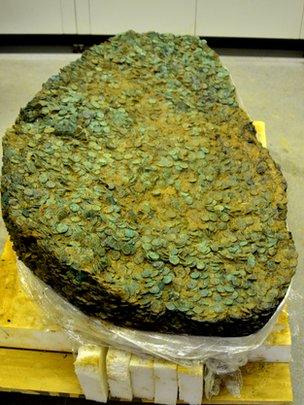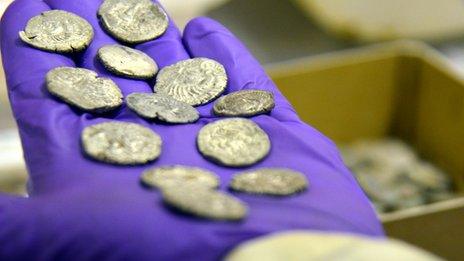Jersey coin hoard left by Celtic tribe in flight from Caesar army
- Published

Mr Mahrer says it will take up to eight years to remove all of the coins
An expert working to discover the secrets of a large hoard of Celtic coins says they were left by people running from Julius Caesar's invading army.
Neil Mahrer, from Jersey Heritage, has been tasked with separating and cleaning what is thought to be about 70,000 coins - the largest find of its kind.
He said on his own, this process could take up to six years but he hopes to be able to employ people to help him with the work.
"Painstaking is the word, because we are doing it as correctly as we can it is going to take time.
"Trying to get as much information as we can from the hoard means recording the positions of all the coins, recording all their treatment, treating them very carefully and slowly," he said.
Coin by coin
Based in a small lab, the mud covered hoard of coins in the middle of the floor, he said they would be working coin by coin.

There are thought to be about 70,000 coins contained within the hoard
Mr Mahrer said: "Doing it virtually coin by coin we are expecting it to take six to eight years for one person. We hope to employ two other people than myself and do it in a two to three year period."
Jersey Heritage hope to be able to put the cleaned coins and jewellery on display at the Jersey Museum in 2014.
The coins were discovered by two amateur metal detector enthusiasts, Reg Mead and Richard Miles who began their hunt after a woman told them her father had found coins in a field some years before.
Mr Mahrer said it was exciting to have something this historically significant on his doorstep. He said he has been contacted by media and academics from around the world.
"We dug down and found a small patch at the top of it and thought 'that's great', we thought we knew what we were dealing with - a mass of coins the size of a football.
"We slowly went out to find the edges and we hadn't, it went on and on and on. There has been nothing like this in Britain before, or of this kind anywhere in the world," he said.
The coins are thought to have been hidden in the island by tribesmen from Gaul trying to keep it from Caesar and his army around 50 BC.
Within the large block of coins there is jewellery and organic matter that could be the remains of the bags people used to throw the coins into the pit.
Mr Mahrer said: "We assumed it would be a coin hoard but when I started to clear back the surface I found a piece of silver Celtic jewellery. We have no idea how much jewellery or other material is hidden inside.
"Virtually no two are exactly the same, they are all of a known type so far from one tribe on the French coast but we can only see about 1% of the coins in it."
The conservation specialist has spent the past few months painstakingly removing layer after layer of earth to reveal the coins hidden underneath.
But he said that was the first phase and the real work would now begin to separate the coins and jewellery and clean them up.
He said that while the coins clearly had a financial value it was impossible to say exactly what that was until they knew what was actually within the hoard.
'Offshore finance'
The true value, according to Mr Mahrer, is the scientific and historical importance of such a significant find.

Mr Mahrer said no two coins they have uncovered so far are the same
"The importance of this is what we hope to find out about Jersey and France at this time.
"As simple scrap metal it is bound to have some value and as coins on the market it has some value but doing it coin by coin we hope to find out what was put into the hoard at a bag by bag level."
He said the coins came from the Coriosolite tribe, a French Celtic nation that controlled the area around St Malo and Dinan.
"It dates from about 50 or 60 BC which is around the time Julius Caesar invaded Gaul and the two facts are presumably connected.
"This money was rushed to here, it is very tempting to talk about offshore banking but it was certainly removed from the French mainland to here.
"I'm not sure why, whether to be hidden, re-used or somewhere the coins for the tribes were made. It was Celtic tribes fighting the Romans, it was Asterix basically."
- Published10 September 2012
- Published5 July 2012
- Published27 June 2012
- Published26 June 2012
- Published26 June 2012